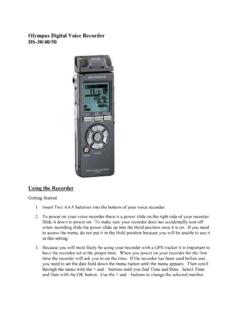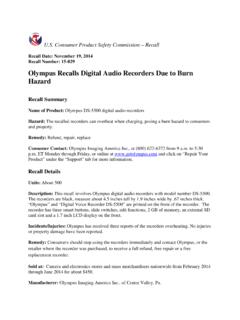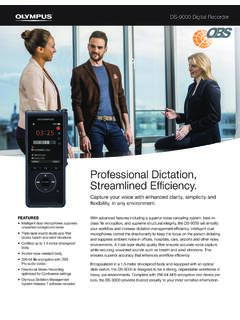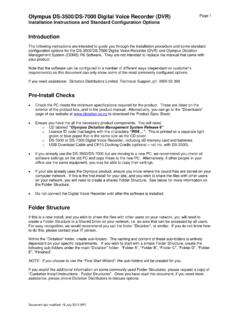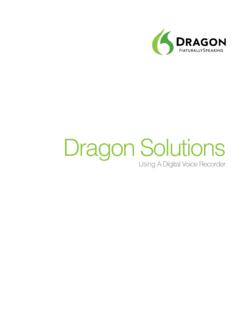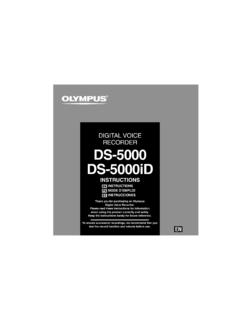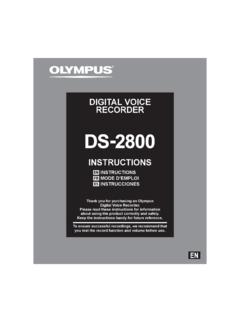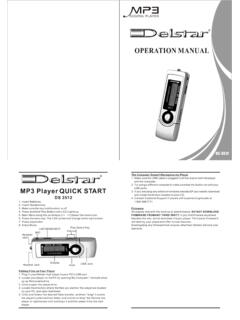Transcription of DIGITAL VOICE RECORDER DS-5500 - Olympus
1 INSTRUCTION MANUALDIGITAL VOICERECORDERT hank you for purchasing an Olympus DIGITAL VOICE read these instructions for information about using the product correctly and the instructions handy for future ensure successful recordings, we recommend that you test the record function and volume before The contents of this document may be changed in the future without advanced notice. Contact our Customer Support Center for the latest information relating to product names and model numbers. The illustration of the screen and the RECORDER shown in this manual may differ from the actual product. The utmost care has been taken to ensure the integrity of this document, but if you find a questionable item, error or omission, please contact our Customer Support Center. Any liability for passive damages or damage of any kind occurred due to data loss incurred by a defect of the product, repair performed by the third party other than Olympus or an Olympus authorized service station, or any other reason is and registered trademarks Microsoft and Windows are registered trademarks of Microsoft Corporation.
2 Macintosh is a trademark of Apple Inc. Intel is the registered trademark of Intel Corporation. SD and SDHC are the trademarks of SD Card Association. Other product and brand names mentioned herein may be the trademarks or registered trademarks of their respective of contentsIntroductionSafety precautions ..41 Getting startedMain features ..9 Identification of parts ..10 Display status indicators (LCD panel) ..11 Inserting the batteries ..12 Charging the batteries ..13 Charging the batteries directly via USB cable ..13 Charging the batteries using the docking station ..14 Using the Ni-MH rechargeable supply from AC adapter or USB cable ..17 Turning on/off the RECORDER ..18 Memory card ..18 Compatible cards ..18 Inserting and ejecting a SD battery type and time/date ..20 Setting battery type [Battery].
3 20 Setting time and date [Time & Date] ..202 Basic operationsRecording ..22 New recording ..23 Overwrite recording ..24 Insert recording ..25 Hands-free recording ..26 Recording monitor ..29 Erasing files ..29 Partially erasing a file ..30 Using the hold function ..323 Advanced operationsSelecting folders and files ..33 Displaying file information ..33 Device lock function ..34 Setting the Author ID and Work Type ..35 Verbal Comment ..36 Index marks ..37 How to use the menu ..38 Menu items ..40 File Menu ..40 Rec Menu ..40 LCD/Sound Menu ..41 Device Menu ..42 Editing the Work Type information ..43 Formatting the memory [Format]..45 Customizing the RECORDER ..474 Managing files on your PCODMS and DSS Player software ..49 Minimum requirement ..49 Using online help ..50 Connecting to your PC.
4 51 Connecting to your PC using the USB cable ..51 Connecting to your PC using the docking station ..52 Disconnecting from your PC ..52 Running ODMS and DSS Player software ..53 Using as external memory of the PC ..545 Other informationAlarm message ..56 Accessories (optional) ..58 Specifications ..59 Customer service and support Professional dictation ..604 ENSafety precautionsBefore using your new RECORDER , read this manual carefully to ensure that you know how to operate it safely and correctly. Keep this manual in an easily accessible location for future reference. The warning symbols indicate important safety related information. To protect yourself and others from personal injury or damage to property, it is essential that you always read the warnings and information used in this manual The word card is used to refer to the SD card.
5 The word ODMS is used to refer to the Olympus Dictation Management System in Windows environment. The word DSS Player is used to refer to the DSS Player for Mac in Apple Macintosh for usage environment To protect the high-precision technology contained in this product, never leave the RECORDER in the places listed below, no matter if in use or storage: Places where temperatures and/or humidity are high or go through extreme changes. Direct sunlight, beaches, locked cars, or near other heat sources (stove, radiator, etc.) or humidifiers. Near flammable items or explosives. In wet places, such as bathrooms or in the rain. In places prone to strong vibrations. Never drop the RECORDER or subject it to severe shocks or vibrations. The RECORDER may malfunction if it is used in a location where it is subject to a magnetic/electromagnetic field, radio waves, or high voltage, such as near a TV set, microwave, video game, loud speakers, large monitor unit, TV/radio tower, or transmission towers.
6 In such cases, turn the RECORDER off and on again before further operation. Avoid recording or playing back near cellular phones or other wireless equipment, as they may cause interference and noise. If you experience noise, move to another place, or move the RECORDER further away from such equipment. Do not use organic solvents such as alcohol and lacquer thinner to clean the DangerIf the product is used without observing the information given under this symbol, it may cause serious injury or WarningIf the product is used without observing the information given under this symbol, it may cause injury or CautionIf the product is used without observing the information given under this symbol, it may cause minor personal injury, damage to the equipment, or loss of valuable precautionsWarning regarding data loss: Recorded content in memory may be destroyed or erased by operating mistakes, unit malfunction, or during repair work.
7 It is recommended to back up and save important content to other media such as a computer hard disk. Any liability for passive damages or damage of any kind occurred due to data loss incurred by a defect of the product, repair performed by the third party other than Olympus , an Olympus authorized service station or any other reason is excluded from the Olympus the recorderf Warning: Keep the RECORDER out of the reach of children and infants to prevent the following dangerous situation that could cause serious injury:1 Accidentally swallowing the battery, cards or other small Accidentally being injured by the moving parts of the RECORDER . Do not disassemble, repair or modify the unit yourself. Use SD/SDHC memory cards only. Never use other types of cards. If you accidentally insert another type of card into the RECORDER , contact an authorized distributor or service center.
8 Do not try to remove the card by force. Do not operate the unit while operating a Caution: Stop using the RECORDER immediately if you notice any unusual odors, noise, or smoke around it. Never remove the battery with bare hands, which may cause a fire or burn your hands. Do not leave the RECORDER in places where it may be subject to extremely high temperatures. Doing so may cause parts to deteriorate and, in some circumstances, cause the RECORDER to catch fire. Do not use the charger or AC adapter if it is covered. This could cause overheating, resulting in fire. Handle the RECORDER with care to avoid getting a low-temperature burn. When used for a long period, the RECORDER will get hot. If you hold on to the RECORDER in this state, a low-temperature burn may be caused. In places subject to extremely cold temperatures, the temperature of the RECORDER s body may be lower than the environmental temperature.
9 If possible, wear gloves when handling the RECORDER in cold precautionsUnusable batteriesBatteries whose bodies are only partially or not at all covered by an insulating whose - terminals are raised, but not covered by an insulating whose - terminals are flat and not completely covered by an insulating sheet. (Such batteries cannot be used even if the - terminals are partially covered.) If a battery leaks, becomes discolored or deformed, or becomes abnormal in any other way during operation, stop using the RECORDER . If a battery leaks fluid onto your clothing or skin, remove the clothing and flush the affected area with clean, running cold water immediately. If the fluid burns your skin, seek medical attention immediately. Never mix batteries (old and new batteries, charged and uncharged batteries, batteries of different manufacture or capacity, etc.)
10 Do not use batteries if their body is not covered by the insulating sheet or if the sheet is torn, as this may cause fluid leaks, fire or handling precautionsf Danger: The battery should never be exposed to flame, heated, short-circuited or disassembled. Never heat or incinerate battery. Take precautions when carrying or storing batteries to prevent them from coming into contact with any metal objects such as jewelry, pins, fasteners, etc. To prevent causing battery leaks or damaging their terminals, carefully follow all instructions regarding the use of batteries. Never attempt to disassemble a battery or modify it in any way, solder, etc. If battery fluid gets into your eyes, flush your eyes immediately with clear, cold running water and seek medical attention immediately. When NiMH rechargeable batteries are used, charge them with the specified AC adapter or charger.
